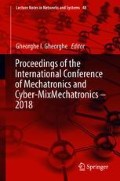Abstract
A comparison between the most important methods for crack detection during external inspection of the pipes is presented. It is meant to choose the best suited one for robotic devices, aimed to perform the pipelines monitoring, because they are often under the action of the environmental stress factors, like high-temperature variation, especially met in the Middle East countries. As a native from the Republic of Iraq, the first author currently works at development of a robot for external inspection of pipes, within his Ph.D. thesis, in order to provide full care to the pipelines, because they are non-replaceable. This way, their performance and reliability can improved and the production stopping is prevented.
Access this chapter
Tax calculation will be finalised at checkout
Purchases are for personal use only
References
Hwang, J., Kim, J., Lee, J.: Magnetic images of surface crack on heated specimen using an area-type magnetic camera with high spatial resolution. In: Instrumentation and Measurement Technology Conference, I2MTC’09, IEEE, 5–7 May 2009, pp. 1546–1551. IEEE (2009)
Shafeek, H.I., Gadelmawla, E.S., Abdel-Shafy, A.A., Elewa, I.M.: Assessment of welding defects for gas pipeline radiographs using computer vision. NDT & E Int. 37(4), 291–299 (2004). (ISSN 0963-8695)
Genest, M., Dudzinski, D. C., Bulmer, S., Kersey, R.K.: Crack detection using induction thermography for thermomechanical fatigue tests. In: AIP Conference Proceedings, vol. 1335, pp. 1727–1734. https://doi.org/10.1063/1.3592137
Wagner, D., Ranc, N., Batthias, C., Paris, P.C.: Fatigue crack initiation detection by an infrared thermography method. Fatigue Fract. Eng. Mater. Struct. 33(1), 12–21 (2010)
Kostson, E., Weekes, V., Almond, D.P., Wilson, V., Tian, G.Y.: Crack detection using pulsing eddy current stimulated thermography. In: AIP Conference Proceedings, vol. 1335, pp. 415–422. https://doi.org/10.1063/1.3591882
Maldague, X., Galmiche, F., Ziadi, A.: Advances in pulsed phase thermography. Infrared Phys. Technol. 43(3–5), 175–181 (2002). (ISSN 1350-4495)
Maffren, T., Juncar, P., Lepoutre, F., Deban, G.: Crack detection in high-pressure turbine blades with flying spot active thermography in the SWIR range. In: AIP Conference Proceedings, vol. 1430, pp. 515–522. https://doi.org/10.1063/1.4716270
Ghidoni, S., Minella, M., Nanni, L., Ferrari, C., Moro, M., Pagello, E., Menegatti, E.: Automatic crack detection in thermal images for metal parts. Department of Information Engineering, University of Padova, Italy
Okolo, C.K., Meydana, T.: Pulsed magnetic flux leakage method for hairline crack detection and characterization. Wolfson Centre for Magnetics, School of Engineering, Cardiff University, UK (2017)
Wu, J., Fang, H., Li, L., Wang, J., Huang, X., Kang, Y., Sun, Y., Tang, C.: A lift-off-tolerant magnetic flux leakage testing method for drill pipes at Wellhead. Electronic Engineering, Newcastle University, UK (2017)
Ibrahim, M., Zakaria, Z., Aiman, A.M., Desmond, D.S., Nasir, M.A., Balkhis, I., Ruzairi, R.R.: Magnetic flux leakage capsule material selection and its robustness analysis in oil and gas pipeline. Sens. Transducer 156(9), 67–74 (2013)
Deng, D., Sun, Y., Kang, Y., Song, K., Wang, R.: A Permeability-Measuring Magnetic Flux Leakage Method for Inner Surface Crack in Thick-Walled Steel Pipe. Springer Science (2017)
Shi, Y., Zhang, C., Li, R., Cai, M., Jia, G.: Theory and application of magnetic flux leakage pipeline detection. Sensors 15, 31036–31055 (2015)
Kajiwara, I., Akita, R., Hosoya, N.: Damage detection in pipes based on acoustic excitations using laser-induced plasma. Mech. Syst. Signal Process. 111, 570–579 (2018)
Integrity Diagnostics homepage: http://www.idinspections.com. Last accessed 2018/06/02
Adnan, N.F., et al.: Leak detection in the gas pipeline by acoustic and signal processing - a review. In: IOP Conference Series: Materials Science and Engineering (2015)
Tezerjani, A.D.: High-resolution visual pipe characterization system using an omni-directional camera. Ph.D., thesis, University of Regina, Saskatchewan (2015)
Jacquey, F., Comby, F., Strauss, O.: Non-additive approach for omnidirectional image gradient estimation. France (2007)
Author information
Authors and Affiliations
Corresponding author
Editor information
Editors and Affiliations
Rights and permissions
Copyright information
© 2019 Springer International Publishing AG, part of Springer Nature
About this paper
Cite this paper
Hashim, A.S., Grămescu, B., Niţu, C. (2019). Pipe Cracks Detection Methods – A Review. In: Gheorghe, G. (eds) Proceedings of the International Conference of Mechatronics and Cyber-MixMechatronics – 2018. ICOMECYME 2018. Lecture Notes in Networks and Systems, vol 48. Springer, Cham. https://doi.org/10.1007/978-3-319-96358-7_19
Download citation
DOI: https://doi.org/10.1007/978-3-319-96358-7_19
Published:
Publisher Name: Springer, Cham
Print ISBN: 978-3-319-96357-0
Online ISBN: 978-3-319-96358-7
eBook Packages: Intelligent Technologies and RoboticsIntelligent Technologies and Robotics (R0)

